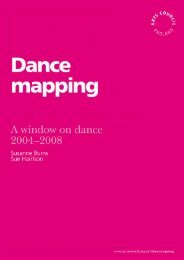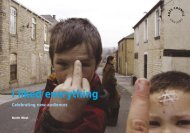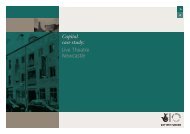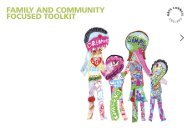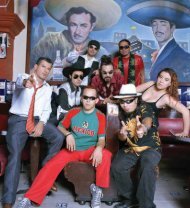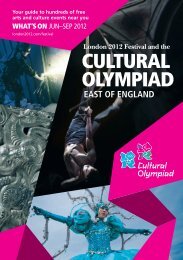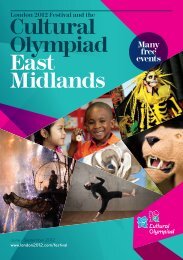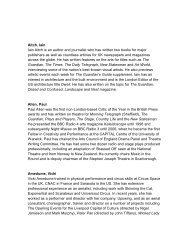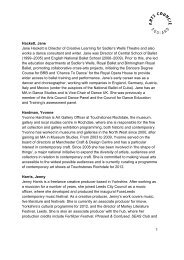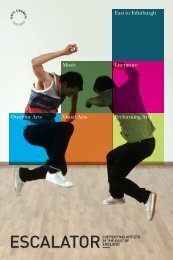Mapping Deaf Arts in the North West - Arts Council England
Mapping Deaf Arts in the North West - Arts Council England
Mapping Deaf Arts in the North West - Arts Council England
Create successful ePaper yourself
Turn your PDF publications into a flip-book with our unique Google optimized e-Paper software.
<strong>Mapp<strong>in</strong>g</strong> <strong>Deaf</strong> <strong>Arts</strong> <strong>in</strong> <strong>the</strong> <strong>North</strong> <strong>West</strong><br />
1 Executive summary<br />
2 Introduction<br />
3 National context<br />
4 Process<br />
i Information circulation<br />
ii Questionnaires<br />
iii Local <strong>in</strong>terviews<br />
iv Art Debate at BDA Regional Event<br />
5 <strong>Deaf</strong> arts <strong>in</strong> <strong>the</strong> <strong>North</strong> <strong>West</strong><br />
i Individual <strong>Deaf</strong> artists<br />
ii Organisations run by <strong>Deaf</strong> BSL users<br />
iii Organisations that have run projects for <strong>Deaf</strong> BSL users<br />
6 F<strong>in</strong>d<strong>in</strong>gs and analysis<br />
i Questionnaires and <strong>in</strong>terviews<br />
ii BDA Regional event<br />
7 Conclusion and recommendations<br />
i Individual artists<br />
ii Organisations and Groups<br />
iii Recommendations<br />
8 Appendices:<br />
Individual artists and organisations identified through <strong>the</strong> mapp<strong>in</strong>g project<br />
<strong>Deaf</strong> Centres <strong>in</strong> <strong>the</strong> <strong>North</strong> <strong>West</strong> of <strong>England</strong><br />
1
<strong>Mapp<strong>in</strong>g</strong> <strong>Deaf</strong> <strong>Arts</strong> <strong>in</strong> <strong>the</strong> <strong>North</strong> <strong>West</strong><br />
1. Executive Summary<br />
1.1 Follow<strong>in</strong>g <strong>Arts</strong> <strong>Council</strong> <strong>England</strong>, <strong>North</strong> <strong>West</strong>’s appreciation that <strong>Deaf</strong> artists<br />
were not well represented with<strong>in</strong> <strong>the</strong>ir portfolio, <strong>the</strong> British <strong>Deaf</strong> Association<br />
(BDA) was <strong>in</strong>vited to map <strong>Deaf</strong> arts activity and ga<strong>in</strong> a sense of <strong>Deaf</strong> arts<br />
and its spectrum, with<strong>in</strong> <strong>the</strong> region.<br />
1.2 The work is timely as <strong>the</strong>re has been considerable change <strong>in</strong> <strong>the</strong> perception<br />
of <strong>Deaf</strong> British Sign Language (BSL) users with<strong>in</strong> <strong>the</strong> arts. <strong>Deaf</strong> artists,<br />
organisations and companies are hav<strong>in</strong>g better recognition and <strong>in</strong>volvement<br />
<strong>in</strong> <strong>the</strong> ma<strong>in</strong>stream. The impact of <strong>the</strong> Disability Discrim<strong>in</strong>ation Act (1995)<br />
and <strong>the</strong> recognition of BSL have triggered <strong>the</strong>se changes.<br />
1.3 The mapp<strong>in</strong>g process <strong>in</strong>cluded <strong>in</strong>formation circulated via email, <strong>the</strong><br />
development and dissem<strong>in</strong>ation of questionnaires, a series of local<br />
meet<strong>in</strong>gs with<strong>in</strong> different locations <strong>in</strong> <strong>the</strong> region and a BDA regional event at<br />
<strong>the</strong> University of Central Lancashire. Over 100 people showed <strong>in</strong>terest <strong>in</strong><br />
attend<strong>in</strong>g <strong>the</strong> event and we had 80 people actually turn up. The region has<br />
a population of <strong>Deaf</strong> BSL users who are <strong>in</strong>volved <strong>in</strong> <strong>the</strong> arts at a<br />
participatory level but few have <strong>the</strong> opportunity to develop <strong>the</strong>ir <strong>in</strong>terest<br />
beyond this.<br />
1.4 Drama activity appeared to be <strong>the</strong> dom<strong>in</strong>ant artform, with a number of<br />
projects operat<strong>in</strong>g across artforms. Few <strong>in</strong>dividual artists were located who<br />
are operat<strong>in</strong>g at a professional level.<br />
1.5 This mapp<strong>in</strong>g process highlighted four ma<strong>in</strong> issues for progression for<br />
<strong>in</strong>dividuals:<br />
• lack of access to ‘ma<strong>in</strong>stream’ arts activity<br />
• lack of <strong>in</strong>volvement <strong>in</strong> <strong>the</strong> ma<strong>in</strong>stream community for professional <strong>Deaf</strong><br />
artists<br />
• lack of susta<strong>in</strong>ed <strong>in</strong>volvement with ma<strong>in</strong>stream arts organisations<br />
• not be<strong>in</strong>g seen as able artists, <strong>in</strong> <strong>the</strong>ir own right<br />
1.6 The organisations and groups appeared to have similar issues:<br />
• lack of susta<strong>in</strong>able <strong>in</strong>come<br />
• lack of def<strong>in</strong>ed artistic vision<br />
• few staff <strong>in</strong>volved with arts backgrounds<br />
• low fees for staff and lack of tra<strong>in</strong><strong>in</strong>g<br />
• limited capacity <strong>in</strong> access<strong>in</strong>g potential vehicles for development of skills<br />
• lack of network<strong>in</strong>g opportunities <strong>in</strong> both <strong>the</strong> ma<strong>in</strong>stream and with<strong>in</strong> <strong>the</strong><br />
<strong>Deaf</strong><br />
community<br />
2
<strong>Mapp<strong>in</strong>g</strong> <strong>Deaf</strong> <strong>Arts</strong> <strong>in</strong> <strong>the</strong> <strong>North</strong> <strong>West</strong><br />
1.7 This report culm<strong>in</strong>ates <strong>in</strong> a series of recommendations. In general, it<br />
suggests that <strong>Arts</strong> <strong>Council</strong> <strong>England</strong>, <strong>North</strong> <strong>West</strong>:<br />
• makes it clear what and who its fund<strong>in</strong>g is for<br />
• leads by example and demonstrates full access to <strong>Deaf</strong> BSL users <strong>in</strong> all<br />
<strong>in</strong>ternal areas<br />
• advocates to raise <strong>the</strong> status and perception of <strong>Deaf</strong> arts at all levels<br />
• ensures that <strong>the</strong> development of <strong>Deaf</strong> arts is present with<strong>in</strong> all artform<br />
strategies<br />
1.8 In relation to applications, it is recommended that <strong>Arts</strong> <strong>Council</strong> <strong>England</strong>,<br />
<strong>North</strong> <strong>West</strong> looks, <strong>in</strong> particular, to promote applications which:<br />
• promote talented and skilled <strong>Deaf</strong> artists and arts workers as role<br />
models<br />
• provide accessible formats which show <strong>the</strong> direct <strong>in</strong>volvement of <strong>Deaf</strong><br />
BSL users <strong>the</strong>mselves with<strong>in</strong> <strong>the</strong> application, <strong>in</strong> particular with<strong>in</strong> <strong>the</strong><br />
expression of artistic vision<br />
• encourage extended and genu<strong>in</strong>e partnerships between <strong>Deaf</strong> arts<br />
groups and ma<strong>in</strong>stream arts organisations/professional artists<br />
• support <strong>in</strong>creased network<strong>in</strong>g between <strong>Deaf</strong> arts <strong>in</strong>dividuals, groups and<br />
organisations<br />
1.9 To supply those <strong>in</strong>volved <strong>in</strong> <strong>the</strong> mapp<strong>in</strong>g process with <strong>the</strong> key f<strong>in</strong>d<strong>in</strong>gs,<br />
contacts and <strong>in</strong>formation on future projects <strong>in</strong> BSL and/or pla<strong>in</strong> English <strong>in</strong><br />
order to ma<strong>in</strong>ta<strong>in</strong> <strong>the</strong> momentum and keep <strong>the</strong>ir trust and will<strong>in</strong>gness to<br />
participate <strong>in</strong> fur<strong>the</strong>r developments.<br />
3
<strong>Mapp<strong>in</strong>g</strong> <strong>Deaf</strong> <strong>Arts</strong> <strong>in</strong> <strong>the</strong> <strong>North</strong> <strong>West</strong><br />
2. Introduction<br />
2.1 The British <strong>Deaf</strong> Association was commissioned to map <strong>Deaf</strong> arts activity<br />
with<strong>in</strong> <strong>the</strong> <strong>North</strong> <strong>West</strong> <strong>in</strong> January 2005 for four months. <strong>Arts</strong> <strong>Council</strong><br />
<strong>England</strong>, <strong>North</strong> <strong>West</strong> recognised that <strong>Deaf</strong> artists were not well represented<br />
with<strong>in</strong> <strong>the</strong>ir portfolio and wanted to ga<strong>in</strong> an <strong>in</strong>sight <strong>in</strong>to activity <strong>in</strong> <strong>the</strong> area <strong>in</strong><br />
order to provide recommendations.<br />
2.2 This report briefly lays out <strong>the</strong> stages of <strong>the</strong> mapp<strong>in</strong>g process, <strong>the</strong> data<br />
collected and <strong>the</strong> f<strong>in</strong>d<strong>in</strong>gs that can be drawn from <strong>the</strong>ir analysis. The report<br />
highlights <strong>the</strong> national context for this work as well as draw conclusions and<br />
recommendations for <strong>Arts</strong> <strong>Council</strong> <strong>England</strong>, <strong>North</strong> <strong>West</strong> to support and<br />
promote.<br />
2.3 The BDA's vision is of a world where <strong>Deaf</strong> BSL users who use sign<br />
language enjoy <strong>the</strong> same rights, responsibilities, opportunities and quality of<br />
life as everyone else. Around 250,000 people <strong>in</strong> <strong>the</strong> UK use BSL on a daily<br />
basis.<br />
The BDA mission is to build a strong and vibrant community of <strong>Deaf</strong> BSL<br />
users, pull<strong>in</strong>g toge<strong>the</strong>r to provide mutual support, equipped with <strong>the</strong><br />
confidence and skills to contribute to society as equal citizens.<br />
There are approximately 70,000 <strong>Deaf</strong> BSL users <strong>in</strong> <strong>the</strong> UK, who are part of<br />
<strong>the</strong> <strong>Deaf</strong> community, with <strong>the</strong>ir own dist<strong>in</strong>ctive language and culture. About<br />
250,000 people, both <strong>Deaf</strong> and hear<strong>in</strong>g, <strong>in</strong> <strong>the</strong> UK use BSL as <strong>the</strong>ir first or<br />
preferred language.<br />
Ownership of BSL, <strong>Deaf</strong> Identity, bil<strong>in</strong>gual education and social <strong>in</strong>clusion<br />
are <strong>the</strong> key elements of <strong>the</strong> BDA’s new vision and it is felt that <strong>the</strong>se aims<br />
could be achieved closer to home, closer to <strong>the</strong> community, to meet each<br />
region’s vary<strong>in</strong>g needs.<br />
A new approach to work<strong>in</strong>g closer to <strong>the</strong> <strong>Deaf</strong> community was by devolv<strong>in</strong>g<br />
national remits, hav<strong>in</strong>g staff <strong>in</strong>volvement and board representatives <strong>in</strong> each region.<br />
This aims to improve l<strong>in</strong>ks with local <strong>Deaf</strong> communities and to develop alliances.<br />
The four aims of <strong>the</strong> BDA will be <strong>the</strong> core expansion of each Area <strong>Deaf</strong><br />
Association.<br />
4
<strong>Mapp<strong>in</strong>g</strong> <strong>Deaf</strong> <strong>Arts</strong> <strong>in</strong> <strong>the</strong> <strong>North</strong> <strong>West</strong><br />
3. National context<br />
3.1 Over <strong>the</strong> last few years, <strong>the</strong>re has been considerable change <strong>in</strong> <strong>the</strong><br />
perception of, and <strong>the</strong>refore <strong>the</strong> potential for, <strong>Deaf</strong> BSL users with<strong>in</strong> <strong>the</strong><br />
arts. <strong>Deaf</strong> BSL users are be<strong>in</strong>g seen more and more as people who, with<br />
full access to <strong>in</strong>formation, can be just as <strong>in</strong>volved <strong>in</strong> all areas of life as<br />
anyone else. Nationally, <strong>the</strong>re are a number of organisations and groups<br />
that are now run and staffed exclusively by <strong>Deaf</strong> BSL users.<br />
3.2 With<strong>in</strong> <strong>the</strong> arts, a number of national <strong>in</strong>itiatives have been recognised as<br />
provid<strong>in</strong>g high quality models, such as <strong>Deaf</strong><strong>in</strong>itely Theatre (London), <strong>North</strong><br />
<strong>West</strong> Disability <strong>Arts</strong> Forum (Merseyside), Common Ground Sign Dance<br />
Theatre (Liverpool), Wolverhampton Film Festival (British <strong>Deaf</strong><br />
Association) and Shape (London), which is a small group of <strong>Deaf</strong> BSL<br />
users with<strong>in</strong> a ma<strong>in</strong>stream organisation. In <strong>the</strong> recent past, Shape<br />
produced a national magaz<strong>in</strong>e, <strong>Deaf</strong> <strong>Arts</strong> UK.<br />
3.3 There are a number of <strong>Deaf</strong> BSL users who are ga<strong>in</strong><strong>in</strong>g recognition as<br />
artists <strong>in</strong> <strong>the</strong>ir own right. This <strong>in</strong>cludes <strong>Deaf</strong> artist Miles Thomas, fashion<br />
journalist Melissa Mostyn, actors Ilan Dwek, Samuel Dore, Carol<strong>in</strong>e<br />
Parker, Fifi and Paula Garfield, Lisa Mills of HoneyBeeTheatre and<br />
physical <strong>the</strong>atre performer Ramesh Meyyappan.<br />
3.4 Tra<strong>in</strong><strong>in</strong>g, once <strong>the</strong> most difficult area to ga<strong>in</strong> entry to for <strong>Deaf</strong> artists, is<br />
slowly becom<strong>in</strong>g more accessible, for example, Ramesh Meyyappan was<br />
fortunate enough to tra<strong>in</strong> at <strong>the</strong> Liverpool Institute for Perform<strong>in</strong>g <strong>Arts</strong><br />
(LIPA). At first, he was <strong>in</strong>formed he should attend courses specially<br />
designed for Disabled artists but after campaign<strong>in</strong>g for his right to be<br />
<strong>in</strong>cluded <strong>in</strong> <strong>the</strong> ma<strong>in</strong>stream, he eventually was allowed to attend a<br />
ma<strong>in</strong>stream course.<br />
3.5 There are a number of underly<strong>in</strong>g drivers support<strong>in</strong>g <strong>the</strong> grow<strong>in</strong>g<br />
emergence of <strong>Deaf</strong> BSL users <strong>in</strong> <strong>the</strong> arts, <strong>in</strong>clud<strong>in</strong>g:<br />
• <strong>the</strong> Disability Discrim<strong>in</strong>ation Act (1995)<br />
• <strong>the</strong> recognition of BSL as a community language<br />
3.6 The Disability Discrim<strong>in</strong>ation Act (DDA) has been empower<strong>in</strong>g for many<br />
<strong>Deaf</strong> BSL users, help<strong>in</strong>g shift <strong>the</strong> perception of <strong>Deaf</strong> BSL users as a group<br />
where <strong>in</strong>dividuals’ access is paramount. The DDA offers <strong>Deaf</strong> people <strong>the</strong><br />
opportunity to access all ma<strong>in</strong>stream services <strong>in</strong> <strong>the</strong>ir first and preferred<br />
language, BSL. Service providers want<strong>in</strong>g to communicate more effectively<br />
with <strong>Deaf</strong> BSL users are attempt<strong>in</strong>g to address communication barriers, as<br />
<strong>the</strong> only people who can judge <strong>the</strong> effectiveness of easy English, pla<strong>in</strong><br />
English and <strong>the</strong> use of video/CD-Rom/DVD format options are <strong>Deaf</strong> BSL<br />
users <strong>the</strong>mselves. There has been a significant rise <strong>in</strong> <strong>the</strong> numbers of<br />
organisations of <strong>Deaf</strong> BSL users produc<strong>in</strong>g <strong>in</strong>formation and tools for<br />
5
<strong>Mapp<strong>in</strong>g</strong> <strong>Deaf</strong> <strong>Arts</strong> <strong>in</strong> <strong>the</strong> <strong>North</strong> <strong>West</strong><br />
improved communication, such as organisations like Remark <strong>in</strong> Greenwich<br />
and Signpost <strong>in</strong> Newcastle.<br />
3.7 The recognition of BSL has led to a higher profile of <strong>the</strong> language as one<br />
that encompasses both <strong>Deaf</strong> and hear<strong>in</strong>g people through communication.<br />
<strong>Deaf</strong> BSL users are now be<strong>in</strong>g more and more recognised as a l<strong>in</strong>guistic<br />
m<strong>in</strong>ority. Art itself is particularly important for deaf people, because as an<br />
oppressed group, it is a tool for expression and thus br<strong>in</strong>gs <strong>the</strong> <strong>Deaf</strong><br />
community toge<strong>the</strong>r and streng<strong>the</strong>ns <strong>the</strong> development of a positive <strong>Deaf</strong><br />
identity and culture.<br />
4. Process<br />
4.1 In order to map <strong>Deaf</strong> <strong>in</strong>volvement <strong>in</strong> <strong>the</strong> arts <strong>in</strong> <strong>the</strong> <strong>North</strong> <strong>West</strong>, <strong>the</strong> follow<strong>in</strong>g<br />
processes were undertaken:<br />
• <strong>in</strong>formation circulation via email and post<br />
• development and dissem<strong>in</strong>ation of questionnaires<br />
• local <strong>in</strong>terviews with <strong>in</strong>dividuals and organisations<br />
• art and culture debate at BDA regional event<br />
4.2 Information circulation<br />
Information about <strong>the</strong> mapp<strong>in</strong>g process was sent to local <strong>Deaf</strong> BSL users,<br />
all local arts officers, and local arts organisations and through <strong>the</strong> <strong>in</strong>ternet to<br />
encourage <strong>in</strong>volvement <strong>in</strong> this area of work.<br />
<strong>Deaf</strong> <strong>in</strong>dividuals practis<strong>in</strong>g <strong>Deaf</strong> arts were identified for network<strong>in</strong>g and<br />
professional development opportunities. Organisations deliver<strong>in</strong>g or<br />
develop<strong>in</strong>g <strong>Deaf</strong> arts events <strong>in</strong> <strong>the</strong> <strong>North</strong> <strong>West</strong> were located as part of this<br />
report.<br />
4.3 To locate new organisations or <strong>in</strong>dividuals, <strong>in</strong>ternet and email research was<br />
undertaken. This <strong>in</strong>cluded:<br />
• research <strong>in</strong> ma<strong>in</strong>stream organisations for <strong>Deaf</strong> <strong>in</strong>clusion<br />
• publication of both <strong>the</strong> process and <strong>the</strong> BSL Recognition - 2 Years<br />
On event via email list<strong>in</strong>gs and mail<strong>in</strong>g out flyers/<strong>in</strong>formation about<br />
<strong>the</strong> conference<br />
• emailed <strong>North</strong> <strong>West</strong> Disability <strong>Arts</strong> Forum (NWDAF) to cross<br />
reference <strong>in</strong>formation and ensure that we had dissem<strong>in</strong>ated<br />
materials to those groups and <strong>in</strong>dividuals <strong>the</strong>y were aware of<br />
• email correspondence with national contacts to identify any known<br />
organisations or <strong>in</strong>dividuals (Shape, <strong>Deaf</strong><strong>in</strong>itely Theatre, etc)<br />
• publication of <strong>the</strong> programme for <strong>the</strong> event with<strong>in</strong> <strong>the</strong> BDA, national<br />
emails and websites, <strong>Deaf</strong>-UK<br />
• web-based research for arts/<strong>Deaf</strong> sites/articles with<strong>in</strong> <strong>the</strong> <strong>North</strong> <strong>West</strong><br />
region<br />
• word of mouth recommendations<br />
6
<strong>Mapp<strong>in</strong>g</strong> <strong>Deaf</strong> <strong>Arts</strong> <strong>in</strong> <strong>the</strong> <strong>North</strong> <strong>West</strong><br />
4.4 Questionnaire<br />
The BDA drafted a questionnaire for <strong>in</strong>dividuals and this was<br />
discussed/amended with <strong>Arts</strong> <strong>Council</strong> <strong>England</strong>, <strong>North</strong> <strong>West</strong>. The<br />
questionnaire was available at each of <strong>the</strong> <strong>in</strong>terviews and at <strong>the</strong> BDA<br />
regional event. This went alongside <strong>the</strong> data protection form so each<br />
organisation/<strong>in</strong>dividual complet<strong>in</strong>g a mapp<strong>in</strong>g form ensured that <strong>the</strong>ir<br />
contact <strong>in</strong>formation could be more widely used.<br />
Individuals <strong>in</strong>terviewed used <strong>the</strong>ir preferred language, English, sign<br />
supported English (SSE) or British Sign Language (BSL).<br />
4.5 Organisations, groups and <strong>in</strong>dividuals were sent questionnaires but a high<br />
number were not returned – <strong>the</strong>re were over 100 questionnaires distributed<br />
and we had 30 returned.<br />
It was found that a majority of <strong>Deaf</strong> BSL users struggled to complete <strong>the</strong>se<br />
questionnaires, as BSL is <strong>the</strong> first or preferred language for this particular<br />
group.<br />
To overcome this we, as a sign language organisation, arranged one to one<br />
meet<strong>in</strong>gs with both <strong>the</strong> <strong>in</strong>terviewer and participant be<strong>in</strong>g fluent <strong>in</strong> sign<br />
language. This is a time consum<strong>in</strong>g method of data collection, which<br />
impacted on <strong>the</strong> number of respondents we were able to <strong>in</strong>clude. Three<br />
<strong>in</strong>terviews were conducted. Please see appendices.<br />
We had 30 questionnaires returned and three <strong>in</strong>terviews were conducted.<br />
Of those 33 notes we have, two men were <strong>in</strong>terviewed and 14 men returned<br />
questionnaires.<br />
There were some situations, especially <strong>in</strong> <strong>the</strong> wider deaf community, where<br />
some people and groups did not wish to be mapped:<br />
• <strong>the</strong>y did not like forms which were not <strong>in</strong> <strong>the</strong>ir first language<br />
• <strong>the</strong>y did not th<strong>in</strong>k that what <strong>the</strong>y do is ‘good enough’ or felt embarrassed<br />
to be <strong>in</strong>cluded<br />
• <strong>the</strong>y did not feel that <strong>the</strong>ir views would be understood or did not<br />
understand <strong>the</strong> project itself<br />
4.6 Local <strong>in</strong>terviews<br />
Interviews were held with five <strong>in</strong>dividual <strong>Deaf</strong> artists from across <strong>the</strong> region.<br />
4.7 It was discovered from <strong>the</strong> <strong>in</strong>terviews with <strong>Deaf</strong> artists <strong>in</strong> <strong>the</strong> <strong>North</strong> <strong>West</strong><br />
that <strong>the</strong>re are barriers to practis<strong>in</strong>g as a <strong>Deaf</strong> artist. The majority of <strong>Deaf</strong><br />
artists found <strong>the</strong>ir access to <strong>the</strong> arts limited or nonexistent. There is an<br />
7
<strong>Mapp<strong>in</strong>g</strong> <strong>Deaf</strong> <strong>Arts</strong> <strong>in</strong> <strong>the</strong> <strong>North</strong> <strong>West</strong><br />
identified need for sett<strong>in</strong>g up workshops to <strong>in</strong>volve <strong>Deaf</strong> BSL users <strong>in</strong> <strong>the</strong><br />
arts. Most <strong>Deaf</strong> artists were able to develop <strong>the</strong>ir arts skills at<br />
school/colleges; but <strong>the</strong> majority of <strong>the</strong>se <strong>in</strong>dividuals were not able to<br />
develop <strong>the</strong>ir skills fur<strong>the</strong>r after leav<strong>in</strong>g secondary/tertiary education.<br />
4.8 Art and culture debate at BDA regional event<br />
The ‘BSL Recognition - 2 Years On’ event was held at UCLAN (University<br />
of Central Lancashire) on 19 March 2005. The <strong>in</strong>itial target of 75-100<br />
attendees soon had to be revised as over 100 book<strong>in</strong>gs were placed with<strong>in</strong><br />
<strong>the</strong> first two weeks of advertis<strong>in</strong>g <strong>the</strong> event. In total, over 100 people<br />
attended this event and 30 people attended <strong>the</strong> <strong>Arts</strong> and Culture debate<br />
attended by two <strong>Arts</strong> <strong>Council</strong> <strong>England</strong>, <strong>North</strong> <strong>West</strong> officers and one BDA<br />
staff member.<br />
5. <strong>Deaf</strong> <strong>Arts</strong> <strong>in</strong> <strong>the</strong> <strong>North</strong> <strong>West</strong><br />
This section lists <strong>the</strong> organisations and <strong>in</strong>dividuals found as a result of <strong>the</strong><br />
mapp<strong>in</strong>g process.<br />
5.1 Individual <strong>Deaf</strong> artists are <strong>in</strong>cluded <strong>in</strong> <strong>the</strong> appendices.<br />
5.2 Organisations run by <strong>Deaf</strong> BSL users<br />
Common Ground Sign Dance Theatre<br />
Address: Common Ground Sign Dance Theatre, 32-36 Hanover Street,<br />
Gost<strong>in</strong>’s Build<strong>in</strong>g (4th Floor), Hanover Street Liverpool L1 4LN<br />
Email: simeon@signdance.com<br />
Phone/Fax: 0151 707 8033<br />
Text phone: 0151 707 8380<br />
Website: www.signdance.com<br />
Organisation’s statement:<br />
In 1986 Common Ground pioneered a style of dance performance, which<br />
<strong>in</strong>tegrates Sign Language <strong>in</strong>to choreography, creat<strong>in</strong>g a new artform. All our<br />
work is orig<strong>in</strong>al and organic, strongly rooted <strong>in</strong> <strong>Deaf</strong> culture yet fully<br />
accessible to those without any knowledge of Sign Language.<br />
Sign Language, <strong>the</strong> language of <strong>the</strong> <strong>Deaf</strong> community, is a visual, spatial<br />
language tak<strong>in</strong>g shape <strong>in</strong> three dimensions <strong>in</strong> <strong>the</strong> air – this becomes <strong>the</strong> core<br />
of and <strong>in</strong>spiration for our choreography. We create unique performances<br />
through a fusion of sign language, dance, and physical <strong>the</strong>atre, or ‘Poetry of<br />
<strong>the</strong> Body’ (The Guardian).<br />
8
<strong>Mapp<strong>in</strong>g</strong> <strong>Deaf</strong> <strong>Arts</strong> <strong>in</strong> <strong>the</strong> <strong>North</strong> <strong>West</strong><br />
5.3 Organisations which run projects for <strong>Deaf</strong> BSL users<br />
<strong>North</strong> <strong>West</strong> Disability <strong>Arts</strong> Forum (NWDAF)<br />
A Disabled and <strong>Deaf</strong> organisation run by and for Disabled and <strong>Deaf</strong> people.<br />
Address: <strong>North</strong> <strong>West</strong> Disability <strong>Arts</strong> Forum, MPAC Build<strong>in</strong>g, 1-27 Bridport<br />
Street, Liverpool L3 5QF<br />
Email: nwdaf@nwdaf.co.uk<br />
Phone: 0151 707 1733<br />
Website: www.nwdaf.co.uk<br />
Organisation’s statement:<br />
We cover all artforms and work with all disabled people.<br />
We aim to facilitate <strong>the</strong> active participation of Disabled and <strong>Deaf</strong> BSL users<br />
<strong>in</strong> all aspects of <strong>the</strong> arts and creative <strong>in</strong>dustries, and both promote and<br />
celebrate Disability and <strong>Deaf</strong> <strong>Arts</strong> and Culture. Based <strong>in</strong> Liverpool City<br />
Centre, we cover Merseyside, Cheshire, and work throughout <strong>the</strong> U.K. Our<br />
activities <strong>in</strong>clude:<br />
• develop<strong>in</strong>g Disability and <strong>Deaf</strong> arts projects<br />
• ma<strong>in</strong>ta<strong>in</strong><strong>in</strong>g a register of Disabled and <strong>Deaf</strong> artists<br />
• actively promot<strong>in</strong>g Disabled and <strong>Deaf</strong> artists<br />
• research and development<br />
• support<strong>in</strong>g o<strong>the</strong>r Disabled and <strong>Deaf</strong> BSL user arts organisations<br />
• offer<strong>in</strong>g advice and <strong>in</strong>formation<br />
• provid<strong>in</strong>g a Disability Action Tra<strong>in</strong><strong>in</strong>g service<br />
• act<strong>in</strong>g as an access consultancy<br />
Each year, <strong>in</strong> November, we run a big festival – DaDaFest.<br />
Bluecoat <strong>Arts</strong> Centre<br />
Liverpool’s Centre for <strong>the</strong> contemporary arts.<br />
Address: School Lane, Liverpool L1 3BX<br />
Email: adm<strong>in</strong>@bluecoatartscentre.com<br />
Phone: 0151 709 5297<br />
Website: www.bluecoatartscentre.com<br />
Organisation’s statement:<br />
Through a programme called Connect we give lots of people <strong>in</strong> Liverpool <strong>the</strong><br />
chance to work with artists to create art.<br />
The arts programme for <strong>the</strong> centre focuses on visual and perform<strong>in</strong>g arts by<br />
local, regional, national and <strong>in</strong>ternational artists. Bluecoat Gallery presents a<br />
year-round exhibition programme, and live music, dance, literature, live art<br />
events and o<strong>the</strong>r performances are staged <strong>in</strong> a 200 capacity auditorium and<br />
9
<strong>Mapp<strong>in</strong>g</strong> <strong>Deaf</strong> <strong>Arts</strong> <strong>in</strong> <strong>the</strong> <strong>North</strong> <strong>West</strong><br />
<strong>in</strong> Bluecoat's outdoor spaces, as well as o<strong>the</strong>r venues and sites around<br />
Liverpool.<br />
The Connect programme is <strong>the</strong> Bluecoat’s outreach programme, l<strong>in</strong>k<strong>in</strong>g to<br />
various communities with<strong>in</strong> Liverpool and beyond. S<strong>in</strong>ce <strong>the</strong> build<strong>in</strong>g closed<br />
<strong>in</strong> 2005 for major refurbishment, <strong>the</strong> programme concentrates on Connect<br />
projects and artists’ commissions about <strong>the</strong> development.<br />
Participants <strong>in</strong> projects have:<br />
• been empowered to make decisions, shape <strong>the</strong>ir projects and produce<br />
creative work<br />
• had truly life-chang<strong>in</strong>g experiences while explor<strong>in</strong>g <strong>the</strong>ir own creativity<br />
with professional artists<br />
• embarked on journeys of personal development and learned new<br />
skills<br />
• done th<strong>in</strong>gs <strong>the</strong>y never dreamed of do<strong>in</strong>g before - and loved it<br />
• <strong>in</strong>fluenced <strong>the</strong> way Bluecoat presents its ma<strong>in</strong> arts programme, for<br />
<strong>in</strong>stance, how we offer <strong>in</strong>terpretation of our art exhibitions<br />
Our approach is different because:<br />
• artists and groups are carefully matched through detailed consultation<br />
to ensure <strong>the</strong> projects are relevant and appropriate<br />
• projects are allowed to grow organically and relationships are<br />
developed over a long period<br />
• outcomes are not prescribed; <strong>in</strong>stead participants and artists<br />
collaborate on <strong>the</strong> development of a project<br />
• a wide range of creative activity is available, often comb<strong>in</strong><strong>in</strong>g different<br />
arts practices<br />
Full Circle <strong>Arts</strong><br />
Disability arts development agency.<br />
Address: Greenheys Bus<strong>in</strong>ess Centre, 10 Pencroft Way, Manchester M15<br />
6JJ<br />
Email: enquiries@fullcirclearts.co.uk<br />
Fax: 0161 279 7879<br />
Phone: 0161 279 7878<br />
Website: www.full-circle-arts.co.uk<br />
Organisation’s statement:<br />
We work across all artforms, work<strong>in</strong>g with all disabled people.<br />
We provide a full <strong>in</strong>formation and advocacy service for groups or<br />
organisations that want to arrange <strong>the</strong>ir own local Disability <strong>Arts</strong> projects.<br />
We use our years of experience to help groups raise funds, recruit<br />
10
<strong>Mapp<strong>in</strong>g</strong> <strong>Deaf</strong> <strong>Arts</strong> <strong>in</strong> <strong>the</strong> <strong>North</strong> <strong>West</strong><br />
members and disabled artists/workshop leaders to organise <strong>the</strong>ir own<br />
project.<br />
We ma<strong>in</strong>ta<strong>in</strong> strong l<strong>in</strong>ks and work <strong>in</strong> partnership with o<strong>the</strong>r Disability <strong>Arts</strong><br />
organisations, arts fund<strong>in</strong>g bodies, local authorities and practitioners, locally,<br />
nationally, and <strong>in</strong>ternationally. Be<strong>in</strong>g regarded as a leader <strong>in</strong> <strong>the</strong> field of<br />
Disability <strong>Arts</strong> practice means we are <strong>in</strong> a strong position to offer advocacy<br />
and support to anyone <strong>in</strong>terested <strong>in</strong> Disability <strong>Arts</strong> throughout <strong>the</strong> region. We<br />
also support arts venues <strong>in</strong> audience development and <strong>in</strong>clusive projects.<br />
We are a Disability <strong>Arts</strong> development agency who believe, that as Disabled<br />
People, we should determ<strong>in</strong>e on our own behalf where and with whom<br />
responsibility for decision-mak<strong>in</strong>g and advocacy should lie. This is why Full<br />
Circle <strong>Arts</strong> is accountable to, controlled and managed by Disabled People.<br />
We run a range of projects ourselves <strong>in</strong>clud<strong>in</strong>g our mentor<strong>in</strong>g programme – a<br />
unique service for disabled people who are <strong>in</strong>terested <strong>in</strong> arts based tra<strong>in</strong><strong>in</strong>g<br />
or employment. Tra<strong>in</strong>ed and experienced mentors who work professionally <strong>in</strong><br />
<strong>the</strong> arts will help to provide focus, network<strong>in</strong>g opportunities and <strong>in</strong>formation.<br />
We have also launched DASA Source – an agency for disabled artists and<br />
groups. DASA Source supports <strong>in</strong>dividuals as well as groups, and is an<br />
<strong>in</strong>tegral part of Source’s commitment to f<strong>in</strong>d<strong>in</strong>g and susta<strong>in</strong><strong>in</strong>g opportunities<br />
with<strong>in</strong> <strong>the</strong> arts for Disabled People, whe<strong>the</strong>r as tra<strong>in</strong><strong>in</strong>g, employment or<br />
identify<strong>in</strong>g sources of fund<strong>in</strong>g.<br />
We have a comprehensive database of disabled artists and Disability <strong>Arts</strong><br />
companies, which is used for ga<strong>in</strong><strong>in</strong>g employment and network<strong>in</strong>g<br />
opportunities with o<strong>the</strong>r artists and/or arts companies. We also liaise with<br />
o<strong>the</strong>r arts organisations, funders and companies on behalf of any artist <strong>in</strong><br />
DASA.<br />
Artists and groups <strong>in</strong> DASA receive a regular newsletter with all <strong>the</strong> latest<br />
employment and project opportunities, <strong>the</strong>y also have access to ‘<strong>the</strong> news’<br />
section on our website, which is updated weekly.<br />
Prism <strong>Arts</strong><br />
<strong>Arts</strong> development <strong>in</strong> Cumbria.<br />
Address: Unit 1, Brampton Bus<strong>in</strong>ess Centre, Union Lane, Brampton CA8<br />
1BX<br />
Email: office@prismarts.fsnet.co.uk<br />
Phone: office hours: 01697 745011<br />
Organisation’s statement:<br />
Our artforms are dance, drama and visual arts.<br />
11
<strong>Mapp<strong>in</strong>g</strong> <strong>Deaf</strong> <strong>Arts</strong> <strong>in</strong> <strong>the</strong> <strong>North</strong> <strong>West</strong><br />
Prism <strong>Arts</strong> exists to support and enable excluded groups <strong>in</strong> Cumbria to<br />
realise <strong>the</strong>ir creative potential and celebrate <strong>the</strong>ir experience through active<br />
participation <strong>in</strong> and exploration of <strong>the</strong> arts. Prism <strong>Arts</strong> was established <strong>in</strong><br />
1987 and became a charitable trust <strong>in</strong> 1992. S<strong>in</strong>ce its <strong>in</strong>ception Prism <strong>Arts</strong><br />
has <strong>in</strong>itiated hundreds of projects throughout Cumbria work<strong>in</strong>g with a wide<br />
range of groups <strong>in</strong>clud<strong>in</strong>g disabled people, elders and those with mental<br />
health difficulties. For example some of our recent projects <strong>in</strong>clude:<br />
• M<strong>in</strong>dfields – six-month project offered a range of creative media to<br />
participants with mental health needs <strong>in</strong> <strong>North</strong> Cumbria<br />
• Mov<strong>in</strong>g Mounta<strong>in</strong>s – dance project with Carlisle Age Concern, creat<strong>in</strong>g a<br />
new piece of choreography for presentation<br />
• Lightn<strong>in</strong>g Strikes - a festival of Disability <strong>Arts</strong> <strong>in</strong>clud<strong>in</strong>g a series of<br />
workshops by disabled artists culm<strong>in</strong>at<strong>in</strong>g <strong>in</strong> a cabaret event<br />
• The Jumpstart project began <strong>in</strong> April 2002, a three year project, funded by<br />
The Diana, Pr<strong>in</strong>ces of Wales Memorial Fund and <strong>the</strong> Regional <strong>Arts</strong><br />
Lottery Programme. The ma<strong>in</strong> aims of <strong>the</strong> project were to establish a<br />
self-sufficient <strong>Deaf</strong> perform<strong>in</strong>g arts group, to work with groups throughout<br />
Cumbria<br />
• Prism <strong>Arts</strong> <strong>in</strong> partnership with <strong>Arts</strong> <strong>Council</strong> <strong>England</strong>, <strong>North</strong> <strong>West</strong>, Full<br />
Circle <strong>Arts</strong> and <strong>North</strong> <strong>West</strong> Disability <strong>Arts</strong> offered bursaries to disabled<br />
artists <strong>in</strong> <strong>the</strong> <strong>North</strong> <strong>West</strong> region and planed a major exhibition of <strong>the</strong>ir<br />
work at <strong>the</strong> Brewery <strong>Arts</strong> Centre <strong>in</strong> Cumbria <strong>in</strong> March 2004<br />
• Sp<strong>in</strong>n<strong>in</strong>g Yarns provides arts programme for older people <strong>in</strong> Cumbria<br />
Organisation’s statement:<br />
We are <strong>in</strong>volved <strong>in</strong> <strong>the</strong> arts for fun, tra<strong>in</strong><strong>in</strong>g and a liv<strong>in</strong>g.<br />
6. F<strong>in</strong>d<strong>in</strong>gs and analysis<br />
This was <strong>the</strong> most difficult area to develop as <strong>the</strong> staff member responsible<br />
for this project left <strong>the</strong> BDA halfway through. It has been very difficult to<br />
track down exactly how many questionnaires were actually distributed and<br />
how many of <strong>the</strong>se questionnaires were conducted through <strong>in</strong>terviews.<br />
The questionnaires and <strong>the</strong> <strong>in</strong>terviews have not been transcribed very well<br />
as it appears that <strong>the</strong>se were conducted <strong>in</strong> BSL and very short notes were<br />
written. The author did not expand on <strong>the</strong>se notes <strong>the</strong>refore general<br />
assumptions have been made.<br />
Some are very detailed and written <strong>in</strong> ‘<strong>Deaf</strong>’ English, which <strong>in</strong>dicates that<br />
<strong>in</strong>terviews with <strong>the</strong>se <strong>in</strong>dividuals may have derived more <strong>in</strong>formation. All <strong>the</strong><br />
feedback with<strong>in</strong> <strong>the</strong>se questionnaires has been <strong>in</strong>corporated <strong>in</strong> this report<br />
and its f<strong>in</strong>d<strong>in</strong>gs.<br />
Participants <strong>in</strong> <strong>in</strong>terviews and questionnaires expressed a desire to be<br />
<strong>in</strong>cluded <strong>in</strong> poetry writ<strong>in</strong>g, drama, multimedia, digital photography,<br />
photography and pottery.<br />
12
<strong>Mapp<strong>in</strong>g</strong> <strong>Deaf</strong> <strong>Arts</strong> <strong>in</strong> <strong>the</strong> <strong>North</strong> <strong>West</strong><br />
Participants felt <strong>the</strong>y wanted <strong>Deaf</strong> BSL users to be <strong>in</strong>volved <strong>in</strong> <strong>the</strong> arts <strong>in</strong> a<br />
variety of ways. For example, <strong>Deaf</strong> participants mentioned <strong>the</strong>y wanted to<br />
work with <strong>the</strong> <strong>Arts</strong> <strong>Council</strong> to br<strong>in</strong>g about positive development for <strong>Deaf</strong> BSL<br />
users. <strong>Deaf</strong> artists have worked <strong>in</strong> <strong>the</strong> arts, but felt that <strong>the</strong>y could not make<br />
progress, due to lack of funds to undertake appropriate tra<strong>in</strong><strong>in</strong>g courses,<br />
lack of <strong>in</strong>formation for <strong>Deaf</strong> BSL users and access needs and lack of places<br />
to go where <strong>the</strong>y can develop <strong>the</strong>ir skills.<br />
‘English is not my first language. My second year [at university] went<br />
downhill. I took a year out and <strong>the</strong>n did not want to go back, cos of <strong>the</strong><br />
barriers. I practised my lip-read<strong>in</strong>g and tried to sign but couldn’t do it. There<br />
were no deaf people <strong>in</strong> <strong>the</strong> area to help me’<br />
‘I know that deaf people want to be actors or camera operators – <strong>the</strong><br />
problem is <strong>the</strong> <strong>in</strong>terview process, hear<strong>in</strong>g people concentrate on <strong>the</strong> tone of<br />
voice and not on sign language’<br />
‘We need more <strong>in</strong>terpreters for deaf people’<br />
6.1 <strong>Arts</strong> and Culture debate at BDA event ‘BSL Recognition - 2<br />
Years On’<br />
The workshop on ‘<strong>Arts</strong> and Culture’ at <strong>the</strong> BDA regional conference on 19<br />
March 2004 was held to identify any <strong>Deaf</strong> BSL users <strong>in</strong>volved <strong>in</strong> <strong>the</strong> arts,<br />
what <strong>the</strong> <strong>Deaf</strong> community would like to see promoted and to identify any<br />
arts development <strong>in</strong> <strong>the</strong> <strong>North</strong> <strong>West</strong>.<br />
Participants felt <strong>the</strong>y wanted to encourage <strong>Deaf</strong> BSL users to be <strong>in</strong>volved <strong>in</strong><br />
<strong>the</strong> arts <strong>in</strong> a variety of ways. For example, <strong>Deaf</strong> participants mentioned <strong>the</strong>y<br />
wanted to work with <strong>the</strong> <strong>Arts</strong> <strong>Council</strong> to br<strong>in</strong>g about positive development<br />
for <strong>Deaf</strong> BSL users. Many <strong>Deaf</strong> artists have worked <strong>in</strong> <strong>the</strong> arts but felt that<br />
<strong>the</strong>y could not make progress, due to lack of funds to undertake appropriate<br />
tra<strong>in</strong><strong>in</strong>g or courses, lack of <strong>in</strong>formation about <strong>Deaf</strong> BSL users, <strong>the</strong> need for<br />
accessibility and lack of places to go where <strong>the</strong>y can develop <strong>the</strong>ir skills.<br />
Most <strong>Deaf</strong> participants mentioned <strong>the</strong>y enjoyed <strong>the</strong> <strong>the</strong>atre and <strong>the</strong>y wanted<br />
to see more <strong>Deaf</strong> comedy, or <strong>Deaf</strong> BSL users mix<strong>in</strong>g with hear<strong>in</strong>g people<br />
and creat<strong>in</strong>g a show. Participants felt <strong>the</strong> underly<strong>in</strong>g <strong>the</strong>me <strong>in</strong> <strong>the</strong>atre with<br />
<strong>Deaf</strong> BSL users <strong>in</strong>volved can be quite political. <strong>Deaf</strong> BSL users may be<br />
us<strong>in</strong>g arts to convey <strong>the</strong>ir feel<strong>in</strong>gs about political situations, such as <strong>the</strong>ir<br />
rights or recognition of sign language. It was agreed that <strong>Deaf</strong> BSL users<br />
need to be given <strong>the</strong> opportunity to relate to a wider range of current and<br />
historical issues with<strong>in</strong> <strong>the</strong> <strong>the</strong>atre sett<strong>in</strong>g, whe<strong>the</strong>r act<strong>in</strong>g or <strong>in</strong> <strong>the</strong><br />
audience.<br />
13
<strong>Mapp<strong>in</strong>g</strong> <strong>Deaf</strong> <strong>Arts</strong> <strong>in</strong> <strong>the</strong> <strong>North</strong> <strong>West</strong><br />
‘There could be <strong>Deaf</strong> political comedy mak<strong>in</strong>g jokes about <strong>the</strong> hear<strong>in</strong>g<br />
world’ – participant <strong>in</strong> debate.<br />
‘<strong>Deaf</strong> poetry would allow for a high standard of BSL to be used <strong>in</strong> <strong>the</strong> arts’ –<br />
participant <strong>in</strong> debate.<br />
A participant mentioned that <strong>the</strong> Bluecoat Theatre <strong>in</strong> Liverpool may have a<br />
gallery for <strong>Deaf</strong> and disabled people to display <strong>the</strong>ir work when it has<br />
f<strong>in</strong>ished its renovation process. O<strong>the</strong>r venues identified were <strong>the</strong> Tate<br />
Gallery <strong>in</strong> Liverpool hav<strong>in</strong>g an <strong>in</strong>terest <strong>in</strong> display<strong>in</strong>g <strong>Deaf</strong> people’s work. It<br />
was generally felt visual arts are hidden and <strong>the</strong>y wanted to br<strong>in</strong>g all <strong>the</strong><br />
arts work toge<strong>the</strong>r and show <strong>the</strong> variety of skills with<strong>in</strong> <strong>the</strong> <strong>Deaf</strong> community.<br />
In <strong>the</strong> workshop, it was mentioned that <strong>the</strong> <strong>North</strong> <strong>West</strong> is a big area, and<br />
many people felt that <strong>Deaf</strong> arts development needs to be led by <strong>the</strong> <strong>Deaf</strong><br />
community, as this would reflect what <strong>Deaf</strong> BSL users <strong>in</strong> <strong>the</strong> community<br />
want.<br />
A participant felt <strong>Deaf</strong> BSL users meet double barriers when try<strong>in</strong>g to work<br />
<strong>in</strong> <strong>the</strong> <strong>the</strong>atre or TV. For example, <strong>the</strong>y might need one <strong>Deaf</strong> person to take<br />
a job for a part <strong>in</strong> a film and <strong>the</strong>re would be a queue of <strong>Deaf</strong> BSL users<br />
want<strong>in</strong>g <strong>the</strong> job, all of who may not necessarily have ga<strong>in</strong>ed <strong>the</strong> appropriate<br />
tra<strong>in</strong><strong>in</strong>g or qualification.<br />
It was identified that <strong>Deaf</strong> BSL users are not be<strong>in</strong>g offered opportunities<br />
outside of degree education to fur<strong>the</strong>r <strong>the</strong>ir skills <strong>in</strong> <strong>the</strong> arts field. There is a<br />
general <strong>in</strong>accessibility to postgraduate courses for <strong>Deaf</strong> BSL users; barriers<br />
identified <strong>in</strong>cluded, <strong>the</strong>refore, that <strong>the</strong>y have had to apply for alternative<br />
forms of employment to fur<strong>the</strong>r <strong>the</strong>ir careers.<br />
The general consensus is that <strong>the</strong>re is a need for more arts development <strong>in</strong><br />
<strong>the</strong> <strong>Deaf</strong> BSL community <strong>in</strong> <strong>the</strong> <strong>North</strong> <strong>West</strong> of <strong>England</strong>.<br />
‘We want to develop events like <strong>the</strong> DaDaFest – it used to be tokenistic. We<br />
had to get angry to get <strong>Deaf</strong> people accepted’<br />
7. Conclusion and recommendations<br />
7.1 Throughout <strong>the</strong> UK, <strong>the</strong>re are numerous barriers to <strong>Deaf</strong> BSL users’<br />
<strong>in</strong>volvement and progression with<strong>in</strong> <strong>the</strong> arts: lack of access to tra<strong>in</strong><strong>in</strong>g, to<br />
opportunities, lack of access through communication support, negative<br />
assumptions by o<strong>the</strong>rs about <strong>the</strong> capabilities and potential of <strong>Deaf</strong> BSL<br />
users and so on. However, ma<strong>in</strong>ly <strong>in</strong> London, <strong>Deaf</strong> BSL users have been<br />
able, at both an <strong>in</strong>dividual, group and organisational level, to push through<br />
<strong>the</strong>se barriers. Where <strong>the</strong>y have, it has been a long-term process with direct<br />
support from <strong>in</strong>dividuals with<strong>in</strong> <strong>the</strong> arts fund<strong>in</strong>g system.<br />
14
<strong>Mapp<strong>in</strong>g</strong> <strong>Deaf</strong> <strong>Arts</strong> <strong>in</strong> <strong>the</strong> <strong>North</strong> <strong>West</strong><br />
7.2 Individual artists<br />
It was discovered from <strong>the</strong> <strong>in</strong>terviews with <strong>Deaf</strong> artists <strong>in</strong> <strong>the</strong> <strong>North</strong> <strong>West</strong><br />
that <strong>the</strong>re are generally barriers to practis<strong>in</strong>g as a <strong>Deaf</strong> artist. The majority<br />
of <strong>Deaf</strong> artists found <strong>the</strong>ir access to <strong>the</strong> arts limited or nonexistent. There is<br />
an identified need for sett<strong>in</strong>g up workshops to <strong>in</strong>volve <strong>Deaf</strong> BSL users <strong>in</strong> <strong>the</strong><br />
arts. Most <strong>Deaf</strong> artists were able to develop <strong>the</strong>ir arts skills at<br />
school/colleges; but <strong>the</strong> majority of <strong>the</strong>se <strong>in</strong>dividuals were not able to<br />
develop <strong>the</strong>ir skills fur<strong>the</strong>r after leav<strong>in</strong>g secondary/tertiary education.<br />
Organisations and Groups<br />
NWDAF has <strong>Deaf</strong> BSL user representation and this is an area of expertise<br />
that could be shared with many more <strong>Deaf</strong> organisations. Particularly<br />
ga<strong>in</strong><strong>in</strong>g expertise at board level for <strong>Deaf</strong> BSL users. Very few projects<br />
reported us<strong>in</strong>g <strong>Deaf</strong> BSL users <strong>the</strong>mselves to lead or work on projects as<br />
artists and role models. As reported previously, nationally <strong>the</strong>re are a<br />
grow<strong>in</strong>g number of artists and companies us<strong>in</strong>g and employ<strong>in</strong>g <strong>Deaf</strong> BSL<br />
users <strong>in</strong> this way. Although <strong>the</strong>re can be transport and accommodation<br />
expenses br<strong>in</strong>g<strong>in</strong>g <strong>in</strong> <strong>Deaf</strong> BSL users from o<strong>the</strong>r areas.<br />
It appears that some ma<strong>in</strong>stream arts organisations have a significant<br />
<strong>in</strong>volvement with <strong>Deaf</strong> BSL users; this appears to be developed through<br />
form<strong>in</strong>g a group for a specific purpose, ra<strong>the</strong>r than actually focus<strong>in</strong>g on<br />
<strong>in</strong>dividual development.<br />
There is often pressure to change <strong>the</strong> group focus <strong>in</strong> order to give o<strong>the</strong>rs<br />
<strong>the</strong> opportunity to become <strong>in</strong>volved. Often, fund<strong>in</strong>g constra<strong>in</strong>ts mean that<br />
<strong>the</strong> organisation has to change its focus <strong>in</strong> order to be successful <strong>in</strong><br />
fundrais<strong>in</strong>g. From a participatory perspective, this gives more people <strong>the</strong><br />
chance to take part <strong>in</strong> ma<strong>in</strong>stream; it can be less satisfactory from <strong>the</strong><br />
perspective of a talented <strong>in</strong>dividual, as <strong>the</strong>y are exposed to a level and<br />
context of work and <strong>the</strong>n not given <strong>the</strong> opportunity to expand. This is an<br />
issue that is prevalent across all of disabled people’s <strong>in</strong>volvement <strong>in</strong> <strong>the</strong><br />
arts, not one that is unique to <strong>Deaf</strong> arts.<br />
The majority of arts projects run by organisations are short term, ra<strong>the</strong>r than<br />
susta<strong>in</strong>able, long-term commitments. Large portions of organisations and<br />
<strong>in</strong>dividuals time are spent look<strong>in</strong>g for fund<strong>in</strong>g, and due to <strong>the</strong> lack of<br />
<strong>in</strong>come, projects are tightly budgeted, often focus<strong>in</strong>g on <strong>the</strong>ir length ra<strong>the</strong>r<br />
than <strong>the</strong>ir artistic aims. In many ways, this can be seen as ‘chicken and egg’<br />
– without <strong>the</strong> constant need to f<strong>in</strong>d fund<strong>in</strong>g, groups may have <strong>the</strong> time and<br />
space to develop a greater sense of artistic purpose; yet without this<br />
purpose, <strong>the</strong>y may f<strong>in</strong>d susta<strong>in</strong>able arts fund<strong>in</strong>g <strong>in</strong> particular, harder to<br />
access.<br />
15
<strong>Mapp<strong>in</strong>g</strong> <strong>Deaf</strong> <strong>Arts</strong> <strong>in</strong> <strong>the</strong> <strong>North</strong> <strong>West</strong><br />
Due to <strong>the</strong> limited f<strong>in</strong>ances available, fees for artists/arts workers are<br />
perceived to be low, and f<strong>in</strong>d<strong>in</strong>g skilled people with an aptitude for work<strong>in</strong>g<br />
with <strong>Deaf</strong> BSL users is reported as difficult. There is little tra<strong>in</strong><strong>in</strong>g available<br />
to develop staff, little capacity to attend tra<strong>in</strong><strong>in</strong>g even if it were offered and<br />
projects do not share contacts of staff, to widen <strong>the</strong>ir options.<br />
Network<strong>in</strong>g between <strong>in</strong>dividuals and organisations with<strong>in</strong> <strong>the</strong> region is<br />
m<strong>in</strong>imal, with few people know<strong>in</strong>g about groups and organisations <strong>in</strong> <strong>the</strong>ir<br />
own sub-region, or contacts with<strong>in</strong> <strong>the</strong> region. Groups are l<strong>in</strong>ked <strong>in</strong>to <strong>the</strong><br />
<strong>Deaf</strong> <strong>in</strong>frastructure with<strong>in</strong> <strong>the</strong>ir areas (deaf organisations etc) although few<br />
have formal or <strong>in</strong>formal l<strong>in</strong>ks with <strong>the</strong> equivalent arts <strong>in</strong>frastructure.<br />
General recommendations<br />
i Although <strong>Arts</strong> <strong>Council</strong> <strong>England</strong> does provide funds for participation<br />
and access to arts opportunities, it needs to articulate its fund<strong>in</strong>g<br />
criteria <strong>in</strong> a way <strong>Deaf</strong> BSL users <strong>the</strong>mselves can understand,<br />
preferably through BSL or pla<strong>in</strong> English.<br />
ii <strong>Arts</strong> <strong>Council</strong> <strong>England</strong> needs to advocate and lobby <strong>the</strong> education and<br />
tra<strong>in</strong><strong>in</strong>g sector to ensure that tra<strong>in</strong><strong>in</strong>g options and career progression<br />
routes are opened to <strong>Deaf</strong> BSL users at all levels.<br />
iii <strong>Arts</strong> <strong>Council</strong> <strong>England</strong>, <strong>North</strong> <strong>West</strong> leads by example and<br />
demonstrates exemplary access to <strong>Deaf</strong> BSL users <strong>in</strong> all areas of its<br />
own <strong>in</strong>ternal and external work. This <strong>in</strong>cludes:<br />
• provid<strong>in</strong>g accessible formats for <strong>Deaf</strong> BSL users (for example,<br />
easy English pr<strong>in</strong>t and video/dvd/cd-rom formats) enabl<strong>in</strong>g<br />
<strong>Deaf</strong> <strong>in</strong>dividuals and groups to apply <strong>in</strong> formats accessible to<br />
<strong>the</strong>m<br />
• ensur<strong>in</strong>g that public events are designed to be accessible for<br />
<strong>Deaf</strong> BSL users <strong>in</strong>clud<strong>in</strong>g <strong>the</strong> promotion of caption<strong>in</strong>g at arts<br />
festivals and book<strong>in</strong>g sign language <strong>in</strong>terpreters<br />
• ensur<strong>in</strong>g that <strong>Deaf</strong> BSL users are represented at <strong>Deaf</strong>,<br />
disability and ma<strong>in</strong>stream events<br />
• promot<strong>in</strong>g work with key <strong>Deaf</strong>-led organisations, to hold<br />
specific art based festivals for celebration / encouragement of<br />
<strong>Deaf</strong> art<br />
7.2 <strong>Arts</strong> <strong>Council</strong> <strong>England</strong>, <strong>North</strong> <strong>West</strong> is encouraged to:<br />
• Support ma<strong>in</strong>stream arts organisations and local deaf organisations <strong>in</strong><br />
establish<strong>in</strong>g workshops with <strong>Deaf</strong> artists as role models<br />
• Support local galleries and similar <strong>in</strong> organis<strong>in</strong>g a visual arts exhibition<br />
to show <strong>Deaf</strong> artists work and <strong>in</strong>vite ma<strong>in</strong>stream and <strong>Deaf</strong> organisations<br />
to view<br />
16
<strong>Mapp<strong>in</strong>g</strong> <strong>Deaf</strong> <strong>Arts</strong> <strong>in</strong> <strong>the</strong> <strong>North</strong> <strong>West</strong><br />
• Support campaigns <strong>in</strong> access for <strong>Deaf</strong> artists <strong>in</strong>to <strong>the</strong> ma<strong>in</strong>stream ‘artists<br />
grapev<strong>in</strong>e’<br />
• Support local <strong>Deaf</strong> organisations to organise and establish an annual<br />
<strong>Deaf</strong> <strong>Arts</strong> festival weekend<br />
• Support and promote captioned screen<strong>in</strong>gs at arts festivals<br />
• Support <strong>Deaf</strong> artists <strong>in</strong> be<strong>in</strong>g <strong>in</strong>vited to show work at ma<strong>in</strong>stream<br />
festivals/exhibitions<br />
• Fund<strong>in</strong>g opportunities need to be made accessible through BSL<br />
<strong>in</strong>terpretation of fund<strong>in</strong>g documentation and made as available as<br />
possible to <strong>the</strong> <strong>Deaf</strong> community<br />
• Set up opportunities with<strong>in</strong> <strong>the</strong> <strong>the</strong>atre sector, <strong>in</strong>clud<strong>in</strong>g writ<strong>in</strong>g, drama<br />
and songwrit<strong>in</strong>g workshops<br />
• Encourage fund<strong>in</strong>g applications from organisations, groups, and<br />
<strong>in</strong>dividuals which promote skilled <strong>Deaf</strong> artists and arts workers as role<br />
models, have clear progression routes show<strong>in</strong>g how <strong>Deaf</strong> <strong>in</strong>dividuals<br />
who have ga<strong>in</strong>ed skills and/or confidence through a project are l<strong>in</strong>ked to<br />
fur<strong>the</strong>r provision or opportunities<br />
• Encourage extended and genu<strong>in</strong>e partnerships between <strong>Deaf</strong> arts<br />
groups and ma<strong>in</strong>stream arts organisations/professional artists<br />
Increased network<strong>in</strong>g will <strong>in</strong>spire better work<strong>in</strong>g practices; improve <strong>the</strong><br />
quality of arts work and <strong>the</strong> skills of arts workers. This could be achieved<br />
through a number of <strong>in</strong>itiatives:<br />
• dissem<strong>in</strong>at<strong>in</strong>g <strong>the</strong> list<strong>in</strong>gs from this mapp<strong>in</strong>g process<br />
• encourag<strong>in</strong>g groups to create <strong>the</strong>ir own websites to l<strong>in</strong>k to <strong>Arts</strong><br />
<strong>Council</strong> and local organisations that have <strong>Deaf</strong> people work<strong>in</strong>g with<strong>in</strong><br />
<strong>the</strong>m such as NWDAF etc<br />
• support<strong>in</strong>g an annual regional showcase/network event (which could<br />
be, <strong>in</strong> <strong>the</strong> first <strong>in</strong>stance, l<strong>in</strong>ked to NWDAF’s DaDaFest or o<strong>the</strong>r exist<strong>in</strong>g<br />
programme of events)<br />
• creat<strong>in</strong>g a regional network for <strong>Deaf</strong> arts (follow<strong>in</strong>g <strong>the</strong> Shape,<br />
London-based model)<br />
<strong>Arts</strong> <strong>Council</strong> <strong>England</strong>, <strong>North</strong> <strong>West</strong> should <strong>in</strong>form participants <strong>in</strong> this mapp<strong>in</strong>g<br />
process which recommendations can be progressed. It is suggested that a<br />
summary of <strong>the</strong> key f<strong>in</strong>d<strong>in</strong>gs of this report, <strong>the</strong> contacts section and<br />
<strong>in</strong>formation on what may occur <strong>in</strong> <strong>the</strong> future is provided <strong>in</strong> BSL/ pla<strong>in</strong><br />
English to those who were <strong>in</strong>volved <strong>in</strong> <strong>the</strong> mapp<strong>in</strong>g process <strong>in</strong> order to keep<br />
<strong>the</strong> momentum go<strong>in</strong>g and keep <strong>the</strong>ir trust and <strong>in</strong>volvement <strong>in</strong> future<br />
developments.<br />
17
Appendices<br />
Artists and organisations identified through <strong>the</strong> mapp<strong>in</strong>g project<br />
Individuals Artform Contact About<br />
Ali Briggs <strong>Deaf</strong> actress briggsy@alij54.freeserve.co.uk Ali has appeared <strong>in</strong> Coronation Street<br />
recently as a relative of one of <strong>the</strong><br />
characters. She is well known for her<br />
work as an actress.<br />
Anne Cunn<strong>in</strong>gham Actress/performer acunn<strong>in</strong>gham@supanet.com<br />
Founder member of ‘Nasty Girls’<br />
act<strong>in</strong>g troupe.<br />
Barry Avison Actor barry@nwdaf.co.uk As part of <strong>North</strong> <strong>West</strong> Disability <strong>Arts</strong><br />
Forum and Merseysign, Barry is a<br />
familiar face <strong>in</strong> <strong>the</strong> Liverpool region.<br />
Carol<strong>in</strong>e Parker Actress carosparks@hotmail.com Carol<strong>in</strong>e Parker is one of <strong>the</strong> best<br />
known deaf actresses and cabaret<br />
performers work<strong>in</strong>g <strong>in</strong> <strong>the</strong> UK today.<br />
James McLaughl<strong>in</strong> Sculptor Fax/phone 0151 260 4167 Well known for his sculpture work and<br />
appearance on See Hear!<br />
Jen Dodds Journalist / deafpower@gmail.com Well known <strong>in</strong> <strong>the</strong> <strong>Deaf</strong> community for<br />
songwriter<br />
journalism and for contributions to<br />
<strong>Deaf</strong> media such as British <strong>Deaf</strong> News<br />
and <strong>Deaf</strong> Worlds.<br />
Kathie Hare Cockburn Actress Kathie.HareCockburn@liverpool.gov.uk As part of <strong>the</strong> troupe, Merseysign,<br />
Kathie is a familiar face <strong>in</strong> <strong>the</strong><br />
Liverpool region.<br />
Rachael Hayes Photographer curlie@hair69.freeserve.co.uk Photographer<br />
Ramesh Meyyappan Performer curlyrams@yahoo.com.sg<br />
Well known <strong>in</strong> <strong>the</strong> <strong>Deaf</strong> and<br />
ma<strong>in</strong>stream communities for his mime<br />
work.<br />
18
<strong>Mapp<strong>in</strong>g</strong> d/<strong>Deaf</strong> arts <strong>in</strong> <strong>the</strong> <strong>North</strong> <strong>West</strong><br />
Organisations Artform Contact About<br />
<strong>Arts</strong> <strong>Council</strong> <strong>England</strong>,<br />
<strong>North</strong> <strong>West</strong><br />
Bluecoat <strong>Arts</strong> Centre Visual arts, live art<br />
and perform<strong>in</strong>g arts<br />
All <strong>Arts</strong> <strong>Council</strong> <strong>England</strong>, <strong>North</strong> <strong>West</strong><br />
Manchester House<br />
22 Bridge Street<br />
Manchester M3 3AB<br />
Phone: 0845 300 6200<br />
Fax: 0161 834 6969<br />
Textphone: 0161 834 9131<br />
Website: www.artscouncil.org.uk<br />
Julia Keenan, Disability Officer<br />
Email: julia.keenan@artscouncil.org.uk<br />
Alexandra Turner, Assistant Officer:<br />
Diversity<br />
Email: alexandra.turner@artscouncil.org.uk<br />
Bluecoat <strong>Arts</strong> Centre<br />
School Lane<br />
Liverpool L1 3BX<br />
Phone: 0151 709 5297<br />
Email: adm<strong>in</strong>@bluecoatartscentre.com<br />
British <strong>Deaf</strong> Association British <strong>Deaf</strong> Association<br />
Wilson Patten Street<br />
Warr<strong>in</strong>gton WA1 1PG<br />
<strong>Arts</strong> <strong>Council</strong> <strong>England</strong> is <strong>the</strong> national<br />
development agency for <strong>the</strong> arts <strong>in</strong><br />
<strong>England</strong>, distribut<strong>in</strong>g public money<br />
from Government and <strong>the</strong> National<br />
Lottery.<br />
Bluecoat is <strong>the</strong> oldest visual arts<br />
centre <strong>in</strong> Liverpool and a key venue<br />
for national and <strong>in</strong>ternational visual<br />
arts, live art and perform<strong>in</strong>g arts. It is<br />
a ma<strong>in</strong>stream supporter of <strong>Deaf</strong> arts.<br />
The British <strong>Deaf</strong> Association (BDA)<br />
is <strong>the</strong> largest <strong>Deaf</strong> organisation <strong>in</strong><br />
<strong>the</strong> UK that is run by <strong>Deaf</strong> people.<br />
19
<strong>Mapp<strong>in</strong>g</strong> d/<strong>Deaf</strong> arts <strong>in</strong> <strong>the</strong> <strong>North</strong> <strong>West</strong><br />
Common Ground Sign<br />
Theatre<br />
Phone: 01925 625520<br />
Textphone: 01925 652529<br />
Email: emmac@bda.org.uk<br />
Website: www.signcommunity.org.uk<br />
Emma Coleman, Director – <strong>North</strong><br />
Dance Common Ground Sign Dance Theatre<br />
Gost<strong>in</strong>s Build<strong>in</strong>g<br />
32-36 Hanover Street<br />
Liverpool L1 4LN<br />
Phone: 0151 707 8033<br />
Textphone: 0151 707 8380<br />
Email: simeon@signdance.com<br />
Website: www.signdance.com<br />
Simeon Hart, Manager<br />
<strong>Deaf</strong><strong>in</strong>itely Theatre Theatre <strong>Deaf</strong><strong>in</strong>itely Theatre<br />
Beethoven Centre<br />
Third Avenue<br />
London W10 4JL<br />
Phone: 020 8968 1589<br />
Email: paula@deaf<strong>in</strong>itely<strong>the</strong>atre.co.uk<br />
Paula Garfield, Actress/producer<br />
Common Ground create unique<br />
performances and community<br />
workshops through <strong>the</strong> fusion of sign<br />
language, dance and physical<br />
<strong>the</strong>atre, which are accessible to all<br />
audiences. They have worked with<br />
national <strong>the</strong>atre groups such as<br />
Richard Alston Dance Company.<br />
A <strong>Deaf</strong> <strong>the</strong>atre company based <strong>in</strong><br />
London. All <strong>the</strong>ir work is <strong>Deaf</strong> led but<br />
is accessible to hear<strong>in</strong>g people as<br />
well.<br />
20
<strong>Mapp<strong>in</strong>g</strong> d/<strong>Deaf</strong> arts <strong>in</strong> <strong>the</strong> <strong>North</strong> <strong>West</strong><br />
Enabl<strong>in</strong>g Through Sound<br />
and Music (ETSAM)<br />
Music 3 Thornton Grove<br />
Morecambe LA4 5PU<br />
Phone: 01524 427919<br />
Email: <strong>in</strong>fo@ETSAM.org.uk<br />
Website: www.etsam.org.uk<br />
Full Circle <strong>Arts</strong> All Full Circle <strong>Arts</strong><br />
Greenheys Bus<strong>in</strong>ess Centre<br />
10 Pencroft Way<br />
Manchester M15 6JJ<br />
Phone: 0161 279 7878<br />
Fax: 0161 279 7879<br />
Email: enquiries@fullcirclearts.co.uk<br />
Website: www.fullcirclearts.co.uk<br />
Music and <strong>the</strong> <strong>Deaf</strong> Music Music and <strong>the</strong> <strong>Deaf</strong><br />
The Media Centre<br />
7 <strong>North</strong>umberland Street<br />
Huddersfield HD1 1RL<br />
Phone: 01484 483115<br />
Fax: 01484 483116<br />
Textphone: 01484 483117<br />
Email <strong>in</strong>fo@matd.org.uk<br />
Website: www.matd.org.uk<br />
Paul Whittaker, Artistic Director<br />
University-based research<br />
organisation that enables people<br />
who are hard of hear<strong>in</strong>g or deaf to<br />
listen to music more clearly and<br />
enjoyably.<br />
Full Circle <strong>Arts</strong> is an arts<br />
devleopment agency based <strong>in</strong><br />
Manchester. It is a user-led<br />
company and exists as a regional<br />
resource for Disability <strong>Arts</strong>.<br />
Music and <strong>the</strong> <strong>Deaf</strong> is a unique<br />
charity that br<strong>in</strong>gs music and <strong>the</strong><br />
perform<strong>in</strong>g arts to deaf people and<br />
those who live and work with <strong>the</strong>m.<br />
21
<strong>Mapp<strong>in</strong>g</strong> d/<strong>Deaf</strong> arts <strong>in</strong> <strong>the</strong> <strong>North</strong> <strong>West</strong><br />
<strong>North</strong> <strong>West</strong> <strong>Deaf</strong><br />
Association<br />
<strong>North</strong> <strong>West</strong> Disability<br />
<strong>Arts</strong> Forum (NWDAF)<br />
Email: nwda@bda.org.uk Area <strong>Deaf</strong> Association with <strong>the</strong><br />
British <strong>Deaf</strong> Association.<br />
All <strong>North</strong> <strong>West</strong> Disability <strong>Arts</strong> Forum<br />
<strong>North</strong> <strong>West</strong> Disability <strong>Arts</strong> Forum<br />
MPAC Build<strong>in</strong>g<br />
(NWDAF) is a Disability <strong>Arts</strong><br />
1-27 Bridport Street<br />
Development Agency based <strong>in</strong><br />
Liverpool L3 5QF<br />
Liverpool. They organise <strong>the</strong> annual<br />
DaDaFest, <strong>the</strong> largest celebration of<br />
Phone: 0151 707 1733<br />
Disability and <strong>Deaf</strong> art <strong>in</strong> <strong>the</strong> <strong>North</strong><br />
Fax: 0151 708 9355<br />
Textphone: 0151 706 0365<br />
Email: nwdaf:nwdaf.co.uk<br />
Website: www.nwdaf.co.uk<br />
<strong>West</strong>.<br />
Prism <strong>Arts</strong> All Prism <strong>Arts</strong><br />
Unit 1, Brampton Bus<strong>in</strong>ess Centre<br />
Union Lane<br />
Brampton CA8 1BX<br />
Phone: 016977 45011<br />
Fax: 01697 745006<br />
Email: office@prismarts.fsnet.co.uk<br />
Website: www.prism.co.uk<br />
Prism <strong>Arts</strong> exists to support and<br />
enable excluded groups <strong>in</strong> Cumbria<br />
to realise <strong>the</strong>ir creative potential and<br />
celebrate <strong>the</strong>ir experience through<br />
active participation <strong>in</strong> and<br />
exploration of <strong>the</strong> arts.<br />
Visual Motions Film Email: ranjit@visualmotions.co.uk <strong>Deaf</strong> run film company based <strong>in</strong><br />
Bradford<br />
22
Contact<strong>in</strong>g <strong>Deaf</strong> clubs <strong>in</strong> <strong>the</strong> <strong>North</strong> <strong>West</strong><br />
You can search for contact details for <strong>Deaf</strong> clubs <strong>in</strong> <strong>the</strong> <strong>North</strong> <strong>West</strong> at <strong>the</strong><br />
British <strong>Deaf</strong> Associations website www.signcommunity.org.uk<br />
The <strong>in</strong>formation directory can be found <strong>in</strong> <strong>the</strong> <strong>in</strong>formation section and gives<br />
free and unlimited access to search from over 1,700 organisations, groups<br />
and services across <strong>the</strong> UK.<br />
23


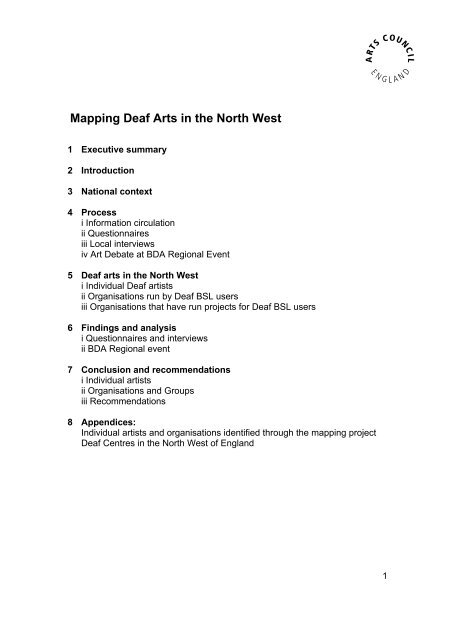

![More than potato prints [PDF 451.9 KB] - Arts Council England](https://img.yumpu.com/19437752/1/190x135/more-than-potato-prints-pdf-4519-kb-arts-council-england.jpg?quality=85)

